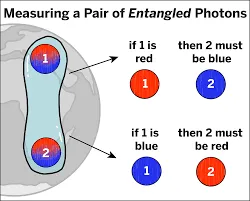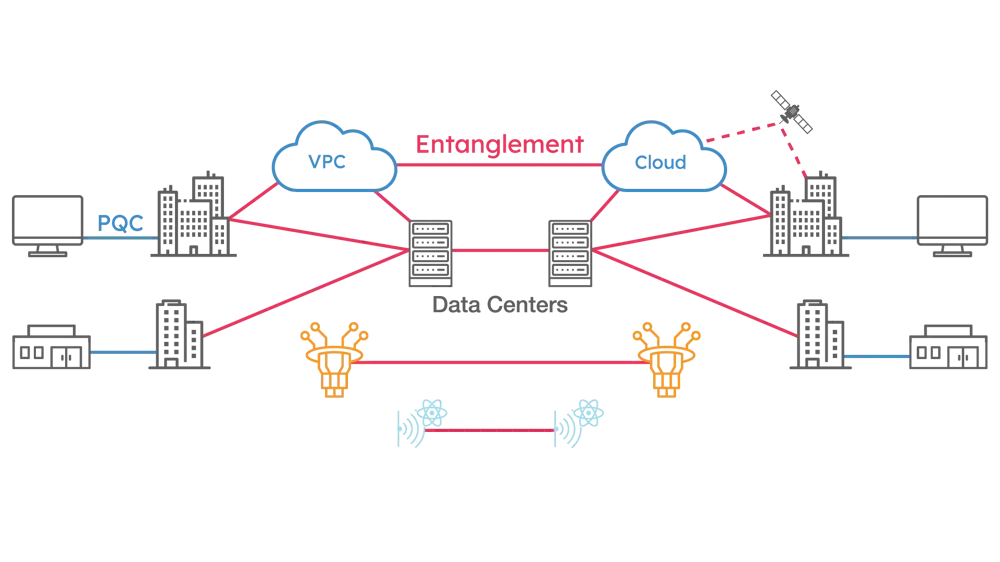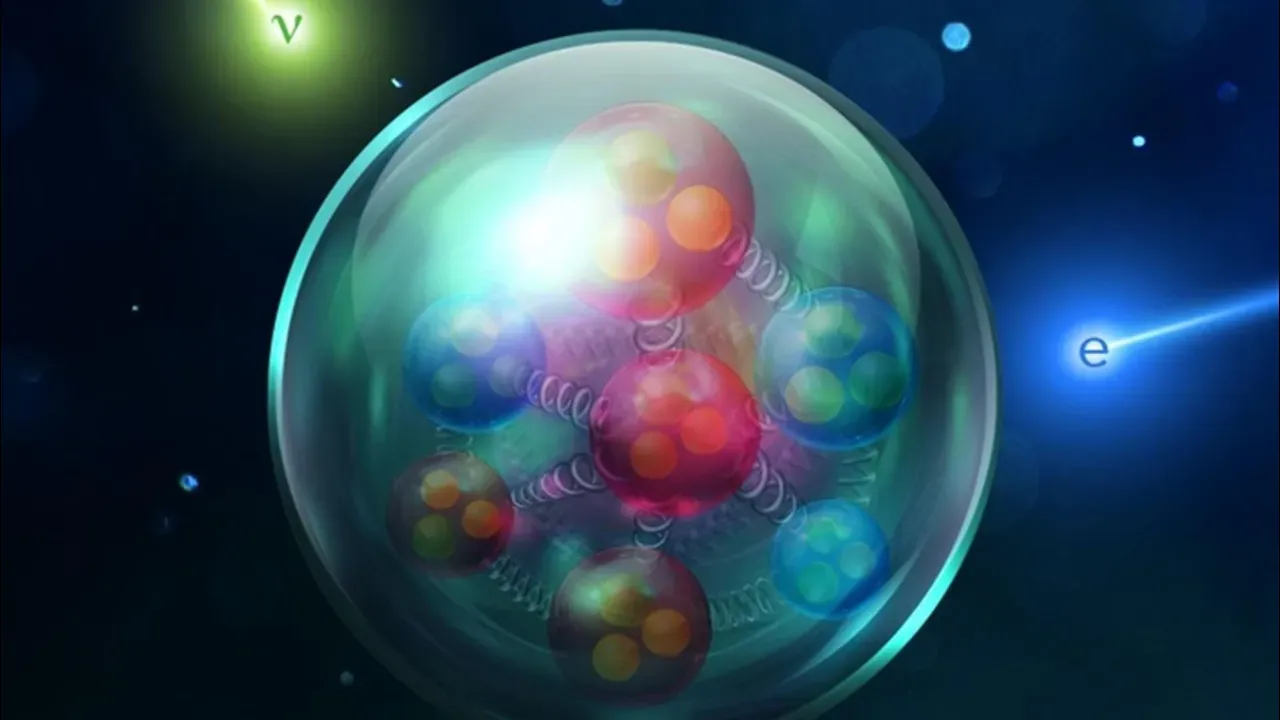Quantum communication in telepathy
Katrina Borthwick - 4th August 2025
The Telepathy Tapes podcast, directed by Ky Dickens and featuring Psychiatrist Dr. Diane Powell, is currently ranking in the top 100 in the US. The podcast makes claims that telepathy has been observed between autistic youths over long distances, and that they can read the minds of those around them. Dr Powell says telepathy might not be paranormal, but rather an extension of normal brain function. She states on her profile on the Parapsychological Association website that she is “collborating [sic] with her brother, theoretical physicist and artificial intelligent expert Ken Hennacy, PhD., on creating a model for understanding consciousness and the quantum world.”

There we go. There’s that word we hear so often as skeptics, ‘quantum’. It seems likely Ky is referring to a state called ‘quantum entanglement’ that results in entangled particles (and photons) having their states correlated over theoretically limitless distances, through tiny wormholes.
Quantum entanglement
First a little disclaimer. I’m a bit thick. No, honestly, I had a look at some of the ‘super simple’ explanations for quantum entanglement and left feeling like I needed a dummies guide to the dummies guide on quantum mechanics. So, here I am, a regular human without a physics degree, attempting to explain what this is. I haven’t used exactly the right scientific words for things where I found them a bit confusing. Be merciful.
It’s hard because quantum entanglement is pretty counterintuitive to understand. In the world we observe everyday we see things behaving in certain ways. For example, if we have two coins and flip them, then each coin can land on ‘heads’ or ‘tails’, but the result of one coin flip is not correlated to the other. The other coin won’t land with the same result as the first coin every time, and it won’t land the opposite every single time. The two outcomes are completely independent of each other. Another example would be two kids on spacehoppers (those big bouncy ball things with handles that kids bounce on around the house when I am trying to have a quiet moment). It may ‘feel’ like they are acting in consort as I try to keep a perilously balanced cup of coffee upright. But the reality is that the first kid is bouncing up and down in one direction, and the other one is doing lordy knows what. There is no correlation between their movement unless there is some sort of outside force, such as snacks involved, then maybe they might head in the same direction, but still bouncing off various things as they go. These are examples of the world we expect to see.

Superposition, on the other hand, is a system a bit like an invisible seesaw, with one kid on each side. The two kids have become ‘entangled’ by getting on the seesaw at the same time. When one kid goes up, the other kid always goes down, without exception. Their movements are correlated. Their entanglement (or system) is powered by a probability field, and their height and speed could be one of any number of values at any point in time. For real quantum entanglement in the world of physics, these would be two particles (scientists usually use photons) that have been manipulated so they are entangled. Interestingly scientists have figured out how to do this more reliably very recently, using a special crystal and a photonic emitter.

The physics of a probability field lets us move the two sides of the invisible seesaw apart without impacting on the relative motion. The system remains intact, despite being separated in space. We can’t know the kids’ positions on the seesaw until we look, but we do know for sure that when one girl is up, the other is definitely down, no matter how far away they are, so long as they are both still on the seesaw. It is not possible for them both to be ‘up’ at the same time, or ‘down’ at the same time. The ‘seesaw system’ won’t allow that. In a similar way, scientists have created entangled photons and moved them hundreds of kilometres apart, and been able to correlate their states at certain points in time, proving that quantum entanglement exists. Einstein, who was thoroughly against its weirdness, dubbed it ‘spooky action at a distance’.
Surprisingly, most things are quantumly entangled in this way. An example would be an atom. We don’t know precisely where all the electrons are, but we do know that the position and motion of all the parts - neutrons, protons and electrons - all act in a correlated way.
Quantum communication
The correlation of properties in quantum entanglement is where the idea of quantum communication comes from. The thinking is that if the two halves of a quantum entangled particle pair are linked in this way, then we might be able to send a message from one side to the other side of the seesaw. Even if it is just binary code, for example ‘up’ for 1 and ‘down’ for 0, it’s all we need for communication.

The trouble with this quantum communication method is that the fulcrum for the seesaw is powered by a probability field that is driven by ‘uncertainties’. It exists because we do not know exactly where something is. If we knew where it was, then it would not be a probability, it would be a ‘certainty’ - and the probability field would collapse. As soon as we make an observation, the system breaks apart and the entanglement ends. Or, in fancy terms, the wave function enters a state of decoherence and collapses.
So, in our seesaw analogy, we introduce a third factor, an observer - let’s call him ‘Dad’. Like us, he can see only one side of the seesaw. He can do a few things here. Perhaps he could observe the position of the girl he sees. This gives him a certain position, but collapses the probability field. Or, alternatively he could try to control the see saw by stopping it or moving it. Again, making the position of his side of the seesaw ‘certain’, this would collapse the probability field. When the probability field collapses, the ‘system’ no longer exists and the quantum entanglement collapses. Or, in this analogy, the kids get off the seesaw in disgust and start bouncing up and down separately on their invisible spacehoppers instead.

However, Dad doesn’t know he’s broken the system. The girl that Dad can see still appears to be going up and down. We know she is bouncing up and down on the infernal spacehopper, but for all he knows she could still be on the seesaw. We can’t tell that the system has collapsed because we are only looking at one side of the seesaw. A disentangled particle (or photon) will carry on moving in the same way, with the same range of possibilities of motion. It just won’t have any correlation to the other particle anymore. So he is measuring something that isn’t there. This point will become important later.
I had considered whether it might be possible to deliberately collapse a bunch of entangled particles, perhaps in some sort of pattern, to send a message. But the kicker is that the collapse happens instantaneously as soon as we try to manipulate them, and the manipulations would not get through to the other end. And just like Dad found, we have no way of telling whether they are still linked. Any attempt to skew things from a normal probabilistic range will collapse things. Even if we don’t touch it, and we just measure it, the particles are moving within the normal range of things, so the only way to know for certain if particles remain entangled would be to make a long distance phone call to check the observations on the other end. And that would totally defeat the purpose of using quantum communication in the first place. It means the only information being exchanged is by the phone, not via quantum powers.
Quantum entanglement as a service
This hasn’t stopped some companies trying to sell quantum communication. A company called Aliro is pitching a future offering called Quantum Entanglement as a Service (QEAAS). Most of the company heads are investor and marketing type people, but their CTO Prineha Narang actually has an impressive background in Physics, and has brought the project over from Harvard. Aliro mainly seems focused on offering quantum computing network services right now, but seems to think they can crack this nut. I will watch this with interest, as sending a message faster than the speed of light defies the laws of physics. As far as I can tell, without being a physicist, the company’s website and various news articles covering it do not explain how they intend to overcome the issue of collapse - although there are several pages of equations that are completely unintelligible to me.

Quantum snake oil
Of course, there are the people just trying to sell snake oil with no idea what quantum entanglement actually is. Even Canada’s Dragon’s Den panel fell for it, and invested in something called Neuroreset in 2017. The company pitched a CA$80 quantum entanglement device that clips on to your clothes:
“physicists infuse a subtle energy pattern into the devices” so it “carries a subtle energy pattern that wakes up the sensory nerve receptors” offering to improve the wearers “balance, control, and strength” and “immediate improvement in your balance and muscle function.”…“This is due to a phenomenon in physics called Quantum Entanglement. A gentle subtle energy field runs between all of the devices and intersects with the nervous system.”
I’m quoting all this second-hand, as their company website domain is now for sale.
Final thoughts
Yes, two particles very very far apart can have their properties correlated, but no, there is no possible way for information to move from one to the other, telepathically or otherwise. The speed of light, a key law of physics, is therefore not violated by quantum entanglement.

My brain is a bit broken at this point, but I’m not the first. As suggested by others, I find a useful way to think about this is that the world isn’t really made up of particles so much as fields, or even systems of fields. After all, most of an atom is empty space, held apart or together by the balancing of various forces. The only reason we don’t fall through the floor is that particles cannot be in the same space at the same time. All of this makes matter as we know it a sort of by-product of the action of these forces. Usually this is on the scale of ‘very tiny things’, so we don’t notice it day-to-day. But when two particles are entangled (sharing the same field or system, and perhaps connected by a tiny wormhole) and then this is used to act over a long distance, we do notice how weird it is. As I said previously, scientists have created entangled photons and moved them hundreds of kilometres apart and been able to correlate their states at certain points in time. We notice these kinds of distances much more than we do the small distances inside an atom, but is it really that different if we think of the universe as being made up of fields and systems?
As a final note, I would like to sincerely thank my younger sister for gifting my two children spacehoppers for Christmas. It was very generous, and the kids really love them!